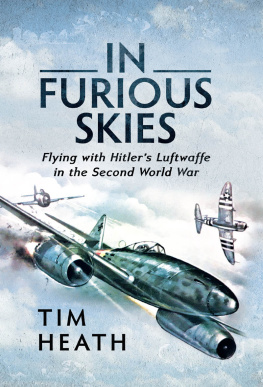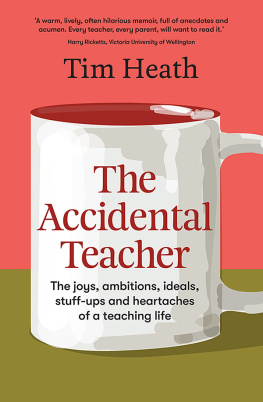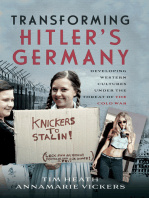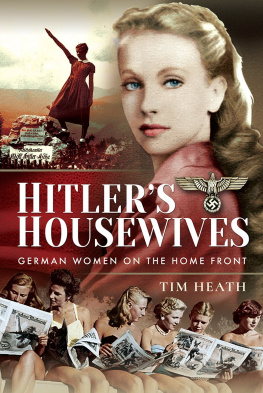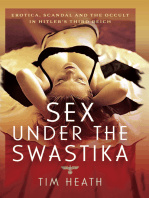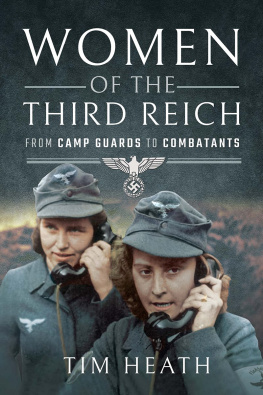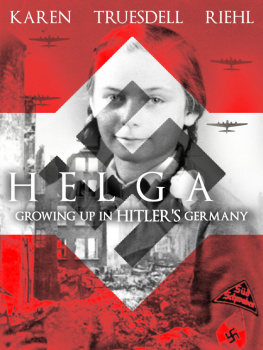
Hitlers Girls
Hitlers Girls
Doves Amongst Eagles
Tim Heath
First published in Great Britain in 2017 by
PEN & SWORD HISTORY
an imprint of
Pen & Sword Books Ltd
47 Church Street
Barnsley
South Yorkshire
S70 2AS
Copyright Tim Heath, 2017
ISBN 978-1-52670-532-7
eISBN 978-1-52670-534-1
Mobi ISBN 978-1-52670-533-4
The right of Tim Heath to be identified as Author of this work has been asserted by him in accordance with the Copyright, Designs and Patents Act 1988.
A CIP catalogue record for this book is available from the British Library.
All rights reserved. No part of this book may be reproduced or transmitted in any form or by any means, electronic or mechanical including photocopying, recording or by any information storage and retrieval system, without permission from the Publisher in writing.
Pen & Sword Books Ltd incorporates the Imprints of Pen & Sword Books Archaeology, Atlas, Aviation, Battleground, Discovery, Family History, History, Maritime, Military, Naval, Politics, Railways, Select, Transport, True Crime, Fiction, Frontline Books, Leo Cooper, Praetorian Press, Seaforth Publishing, Wharncliffe and White Owl.
For a complete list of Pen & Sword titles please contact
PEN & SWORD BOOKS LIMITED
47 Church Street, Barnsley, South Yorkshire, S70 2AS, England
E-mail:
Website: www.pen-and-sword.co.uk
For my Paula, my love, my best friend, my rock, and for women and young girls the world over who are still suffering violence, exploitation and inequality.
Contents
Acknowledgements
I would like to acknowledge the following contributors to this work: Anna Dann, Anita von Schoener, Amy Richardson, Brigitte Schttenkopf, Carly Hendryks, Dora Brunninghausen, Dana Schmidt, Gabrielle Haefker, Horst Frank, Helga Stroh, Helga Bassler, Helena W. Wessel, Inge Scholl, Kirsten Eckermann, Melissa Schroeder, Sophia Kortge, Theresa Moelle, Heidi Koch, Helena Vogel, Ingeborg Schalle, Olga Kirschener, Martina Schepel, Theobald Hortinger, Barbie Densk, Helene Rischer, Elsa Lantz, Dana Henschell, William Anderson, Richard Marshall, Otto Krische and Anita Skorz, all without whom this book would never have been possible.
I would also like to extend my heartfelt thanks to Claire Hopkins, History Editor at Pen & Sword Books Limited, for her help and support given throughout its production and for making Hitlers Girls a reality.
I must also give heartfelt thanks to copy editor and author Gerry van Tonder who has gone above and beyond his duties on this project, Lenny Warren and the Militaria Collectors Network, and Ian Tustin and Lynne Powell of the Vale Magazine .
Introduction
The youth that graduate from my academies will terrify the world!
Adolf Hitler 1930s
I t was during the course of a visit to the German military cemetery at Cannock Chase in Staffordshire, England, in November of 1997, that the idea for Hitlers Girls was conceived. It was a freezing cold, wet and windy morning. I had arrived late at the cemetery, with a view to photographing some graves as part of a research programme being conducted at the time.
I was distracted halfway through my work by the arrival of a group of visitors, which I soon discovered had come from Germany on one of the many excursions organised by the German War Graves Commission at Kassel. Some of the visitors, drawn away from their intended reason for being there, became curious as to what this mad Englishman could possibly be doing trying to take photographs and write notes in such dreadful weather conditions. After a few minutes, one of the German visitors came over, and after some introduction and handshaking, a conversation developed.
As the weather worsened and snow began to fall, we moved into the small reception area of the building where we could continue talking in relative comfort. By this time, the party of German visitors were trekking back and forth to their luxury coach, clutching freshly cooked hotdogs and cups of steaming, hot coffee. Once inside they began to hand out the food and drinks to each other.
One of the female visitors said to me, You must be frozen, and what are you doing to be out here on such a dreadful day?
She then insisted that I have a hotdog and cup of hot coffee before introducing herself:
My name is Kirsten Eckermann and I have come to England for one week with my husband and sister to visit her husbands grave, he had served with the Luftwaffe and was killed over England in 1943.
Naturally the subject of the war became unavoidable. The conversation soon drifted into a period of time that many elderly Germans are still either desperately trying come to terms with or to forget.
I asked Kirsten about her home life and schooling. How had the war affected her and her family, and what it had been like in general to be raised in Hitlers Third Reich? I was very surprised by many of the things she had told me, even more so by the fact that young girls and women also had to join the Hitler Youth. They had no choice, and many had been intimidated into joining.
I had not really had any previous understanding or knowledge of the role of female youth in Nazi Germany. I had previously known little about the two main female Hitler Youth organizations: the Jung Madel (young maidens) for ten to fourteen-year-old girls, and its senior equivalent, the Bund Deutscher Madel (League of German Maidens/BDM) for fourteen-to-eighteen-year-old girls. I did not possess any real understanding of the many unique problems faced by the female youth of Germany or the expectations placed upon their young shoulders by the sometimes contradictory attitudes of their parents and that of the Nazi education system. This frequently led to violence in the home, as girls strived to become independent of their parents strict control.
Kirsten went on to explain that the initial role of German girls under Nazi rule was strictly a passive one, where girls and females in general were confined to the two main functions of motherhood and housekeeping. With the outbreak of war in 1939, and the later unsustainable losses in both human and material resource, the Nazis were forced to dictate changes in policy with regard to the role of its female youth. Kirsten explained that from late 1943 up until the total collapse and surrender of the Third Reich, girls were incorporated into the military. Here they were given detailed instructions on how to use rifles, machine guns, make booby traps, and use anti-tank weaponry. It was all in what amounted to a vain attempt to prevent what was an inevitable Allied victory over Nazi Germany.
It is difficult for many to comprehend that young girls often fought side by side with Wehrmacht soldiers old enough to be their fathers, or formed into some quite effective fighting groups of their own, which in turn would inflict casualties upon the invading Allied forces. Female guerrilla units had been specially formed, seeing combat in and around the Warsaw area against the Red Army in 1944.
It soon became clear to me that the kind of information being exchanged here was that of a highly important nature, and should be documented. I then asked Kirsten if she would be interested in helping me with a view to perhaps producing a book. She agreed to help me as much as she could. We exchanged addresses and shook hands, and Kirsten agreed to talk to some of her friends back in Germany who might also be able to help with information for the proposed book. Subsequently, the work of producing a feasible manuscript was started, along with masses of interviews, via telephone, the Internet and by letter. I also started my search through various archives both here in the UK and in Europe.
Next page

